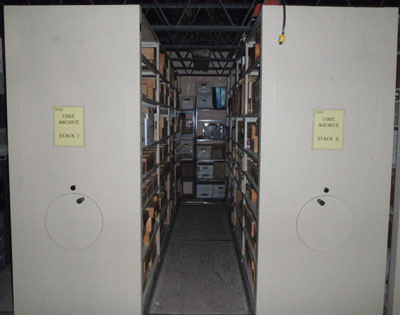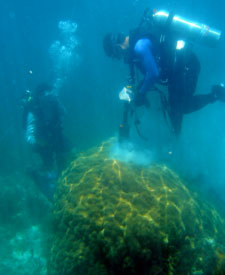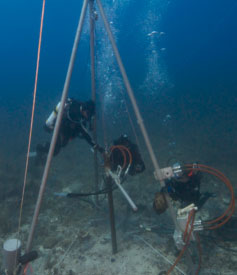Chris Reich
U.S. Geological Survey
St. Petersburg Coastal and Marine Science Center
600 4th Street South
St. Petersburg, FL 33701
(727) 803-8747
Page Contents: |

Figure 1. Photograph of the core archive stacks containing core material. [larger version] |
Introduction
This Web site contains information on rock cores archived at the U.S. Geological Survey (USGS) St. Petersburg Coastal and Marine Science Center (SPCMSC). Archived cores consist of 3- to 4-inch-diameter coral cores, 1- to 2-inch-diameter rock cores, and a few unlabeled loose coral and rock samples. This document—and specifically the archive Web site portal—is intended to be a 'living' document that will be updated continually as additional cores are collected and archived. This document may also contain future references and links to a catalog of sediment cores. Sediment cores will include vibracores, pushcores, and other loose sediment samples collected for research purposes.
This document will: (1) serve as a database for locating core material currently archived at the USGS SPCMSC facility; (2) provide a protocol for entry of new core material into the archive system; and, (3) set the procedures necessary for checking out core material for scientific purposes. Core material may be loaned to other governmental agencies, academia, or non-governmental organizations at the discretion of the USGS SPCMSC curator.
Storage Facility
 Figure 2. Example of organization for Stack I. [larger version]
Figure 2. Example of organization for Stack I. [larger version]The core-archive storage facility (core lab) is located at 600 Fourth Street South, St. Petersburg, Florida, in the SPCMSC. The core lab is an air-conditioned room located in the Getting Building, room B180M. Core material is stored in either wood or cardboard boxes and placed on shelves of five movable storage stacks (fig. 1).
The core material is organized by stack, column, and row (fig. 2). A label is posted above the rotating wheel on each stack to help locate the desired core material. The stacks (roman numerals) are organized with numbered columns and alphabetized rows. For instance, the first sample is located on stack I, row A, column 1 (A1), and the last sample is located on stack V, row HH, column 4 (HH4).
History of the USGS Core Collection
The USGS SPCMSC houses a unique collection of coral and rock cores from all over the world. While the majority of the cores in the collection are from south Florida, there are samples from other locations around the world (for example, Enewetak Atoll, the Philippines, and the U.S. Virgin Islands, an Scorpion and Muleshoe Mounds in the Sacramento Mountains of New Mexico) (Shinn and others, 1983). Cores were collected from live and dead coral heads, as well as from various environments including reef tracts, lagoons, and carbonate islands (Hudson and others, 1976; Shinn and others, 1986; Multer and others, 2002).
The coral and rock cores in the SPCMSC collection were obtained with similar methods (MacIntyre, 1975; Reich and others, 2009). SCUBA divers using a handheld hydraulic drill and a 3.5- to 4-inch diameter diamond-bit core-barrel collected the coral head cores (fig. 3). The cores were collected in approximately 20-inch-long sections. All coral head cores are stored in wooden boxes. The rock cores were collected with a similar SCUBA-diver-operated hydraulic drill, but instead of a 4-inch core, a much smaller 1.5- to 2-inch-diameter core was collected. In order to collect a longer (deeper) geologic sample, a tripod is used to support the weight of the hydraulic drill and core pipe (fig. 4). This drilling method can also be used on land with very little modification to the drilling system. The smaller diameter rock-core samples are stored in cardboard boxes.
 |
 |
|
|
Figure 3. (above left) USGS SCUBA divers taking a coral head core using a hydraulic drill and 4-in-diamter barrel. Photo credit: USGS. [larger version] Figure 4. (above right) USGS hydraulic drilling system utilizing a tripod, hydraulic drill, and NQ2 wireline core barrel to collect long cores. Photo credit: Colm O'Reilly, M/V Spree Expeditions, Inc. [larger version] |
||
Database
 Figure 5. Map showing geospatial information of cores archived at the U.S. Geological Survey's St. Petersburg Coastal and Marine Science Center. The CoreViewer database can be accessed by clicking on the image above.
[larger version]
Figure 5. Map showing geospatial information of cores archived at the U.S. Geological Survey's St. Petersburg Coastal and Marine Science Center. The CoreViewer database can be accessed by clicking on the image above.
[larger version]The primary purpose of this document is to enhance end-user access to a vast core database housed at the SPCMSC core lab. To accomplish this, a Web portal allows the user to search for core material geospatially via a world map. The user follows the Web link to access the core archive database. In order to prepare the core material data and present them in Web format, the database is first encoded in the scripting language PHP (hypertext preprocessor). The PHP-encoded database is linked to an SQL (structured query language) database management system. The archive curator has the capability to access the Web-page database allowing for modification (add, delete, and edit) of the archive records. The external user will be able view the display and download core material information. The core archive database is presented in two formats: (1) a table-driven PHP page and (2) searchable map through an ArcGIS Server. The PHP page displays the core archive records in a tabulated format. The user can search the table by querying information from the database using a simple search field. Eventually, the search field will have advanced features that allow a user to search specific fields using specific terms. The ArcGIS Server format will allow for the core archive data to be "served up" using Viewer for Flex (CoreViewer), which is a Flash-driven mapping interface. The interface allows the user to identify, query, and download archive records from a map interface (http://olga.er.usgs.gov/coreviewer/). The user will be able to zoom in on an area of interest and click on a bullet that marks the location of core archive information. The site and core information for the selected core will appear on the screen. The user can control whether to download the information for that particular core site or to zoom in to a particular area and download the entire archive list for that specified region. The download file is a comma-delimited file (*.csv) or text file (*.txt) that can be imported into most spreadsheet programs.
Loan Agreement Instructions
The SPCMSC may loan, at the discretion of the curator and project lead, the archived material to other interested parties. The loan process begins by requesting the material through the submission of an outgoing loan agreement form (similar to Buczkowski and Kelsey, 2007). The form can be found on this website (Loan_Outgoing_SPCMS.pdf [151 KB]) as an editable pdf file. The outgoing loan agreement form must be submitted to the curator, as denoted on the form, whereby the request will be reviewed and a response to the request will be made. A short proposal is required prior to loaning out any material. Information regarding the type of sampling (alteration of the core material), analyses, and overall purpose of study must be included on the form and in the proposal.
The samples will be returned to the SPCMSC curator, who will sign off on the outgoing loan agreement form and return the core material to its original shelf location. In the event the material is published, kindly acknowledge the St. Petersburg Coastal and Marine Science Center for providing the core material.
Acknowledgment
Kate Ciembronowicz took on the task of creating the original catalog of the core archives. Tom Smith III, Christopher Smith, Caitlyn Reynolds, and Katie Richwine are acknowledged for reviewing and putting the CoreViewer program through a series of tests, greatly improving the look and functionality.
References Cited
Buczkowski, B.J., and Kelsey, S.A., 2007, Archival policies and collections database for the Woods Hole Science Center's marine sediment samples: U.S. Geological Survey Open-File Report 2006-1187, version 1.0, available at https://pubs.usgs.gov/of/2006/1187/.
Hudson, J.H., Shinn, E.A., Halley, R.B., and Lidz, B.H., 1976, Sclerochronology—A tool for interpreting past environments: Geology, v. 4, p. 361-364.
MacIntyre, I.G., 1975, A diver-operated hydraulic drill for coring submerged substrates: Atoll Research Bulletin, v. 185, p. 21-25.
Multer, H.G., Gischler, E., Lundberg, J., Simmons, K.R., and Shinn, E.A., 2002, Key Largo Limestone revisited: Pleistocene shelf-edge facies, Florida Keys, USA: Facies, v. 46, p. 229-272.
Reich, C.D., Hickey, T.D., DeLong, K.L., Poore, R.Z., and Brock, J.C., 2009, Holocene core logs and site statistics for modern patch-reef cores—Biscayne National Park, Florida: U.S. Geological Survey Open-File Report 2009–1246, 26 p., available at https://pubs.usgs.gov/of/2009/1246/.
Shinn, E.A., Kindinger, J.L., Halley, R.B., and Hudson, J.H., 1986, Scuba observations of OAK and KOA Craters, chapter H, in Folger, D.W., ed., Seafloor observations and subbottom seismic characteristics of OAK and KOA Craters, Enewetak Atoll, Marshall Islands: U.S. Geological Survey Bulletin 1678, p. H1-H39.
Shinn, E.A., Robbin, D.M., Lidz, B.H., and Hudson, J.H., 1983, Influence of deposition and early diagenesis on porosity and chemical compaction in two Paleozoic buildups—Mississippian and Permian age rocks in the Sacramento Mountains, New Mexico, in Harris, P.M., ed., Carbonate Buildups—A Core Workshop: Society of Economic Paleontologists and Mineralogists Annual Meeting, Core Workshop No. 4, Dallas, April 1983, p. 182-222.
Suggested Citation
Reich, Chris, Streubert, Matt, Dwyer, Brendan, Godbout, Meg, Muslic, Adis, and Umberger, Dan, 2012, St. Petersburg Coastal and Marine Science Center's Core Archive Portal: U.S. Geological Survey Data Series 626, available at https://pubs.usgs.gov/ds/626/.
Adobe Reader or similar software is required to view PDF documents. Download the latest version of Adobe Reader, free of charge.

